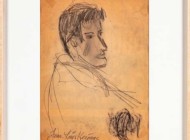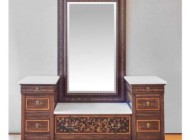
Top lot in the sale was antique Tibetan thangka of Kurukulla (Red Tara), the “love goddess” from a Main Line Philadelphia collection, which handily surpassed an estimation of $500-$1,000 to finish at $11,250.
Review by W.A. Demers; Photos Courtesy Material Culture
PHILADELPHIA — Across Time And Culture | Ethnographic, Ancient, Asian & Textile Arts was the title of a live showroom auction at Material Culture on September 28. The sale was well attended, according to George Jevremovic, founder and principal auctioneer at Material Culture. A total of 1,755 bidders signed up from 18 countries. Of the 663 lots offered, 571 were sold, 92 passed. The sale’s total was $425,100.
Leading the selection of 663 lots was an antique Tibetan thangka of Kurukulla (Red Tara), which handily surpassed an estimation of $500-$1,000 to finish at $11,250. From a Main Line Philadelphia collection, the textile was notable for having a paint-on-cloth image of Red Tara centered on the 25-by-16-inch textile. Kurukulla or Red Tara, is often characterized as the “love goddess,” but only if one’s intentions are selfless. If so, she can help attract those things into one’s life that are needed right now based on one’s karma and the principles of Bodhichitta.
Two Dayak painted shields from Borneo settled at $10,400. Featuring carved wood, pigment and fur, one was sized 47½ by 13¾ by 3½ inches and the other was 50 by 9¼ by 3½ inches. Shields such as these were made by the Dayak Iban tribes to be used in combat and in ceremonial rites. Dynamically carved with tribal motifs from the local Jelutong wood, the shields and their hand grips are normally hewn from one piece of wood.

From the Dayak people of Borneo came an antique women’s work board with a protective spirit face carved in relief. It realized $9,500.
From the same Dayak people came an antique women’s work board. With a protective spirit face carved in relief, the board on stand measured 24¼ by 13¼ by one-half inches and realized $9,500.
Another strong textile performance in the sale was posted by an antique Armenian embroidered cloth with inscriptions. Fetching $7,800 on a $500-$1,000 estimate, the circa 1820 fringed textile utilized silk and metal thread to create a constellation of celestial objects and deities against a crimson background. Its size was 2 feet 7 inches by 2 feet 7 inches.
From the mid-Nineteenth Century, a woman’s overskirt of Inca origin, Aymara Aksu Bolivar, with a rare purple field and a float span design in the upper panel, earned $7,150. Natural dyes were used in this ceremonial textile that came out for festivals, marriages and other important community events.
A Native American highlight, a Navajo blanket, circa 1870s, went out at $6,175. The late transitional classic style wearing blanket had stepped diamond designs in white and indigo blue on a red background of single ply hand-spun Navajo fleece. Its size was 3 feet 10 inches by 5 feet 4 inches.

A Native American Navajo blanket, circa 1870s, went out at $6,175.
Two additional carvings were notable. One was a diminutive Taino Duho of carved tropical hardwood. The ceremonial tray in the form of an anthropo-zoomorphic creature on all fours featured a wide, incised band high on the back, a handle formed by protruding neck and head with typical large eyes and toothy grin. At 6¾ by 11 by 4 inches, the beast made $5,850. The second was an antique Dayak wooden guardian figure, Hampatong, that had been carved in the late Nineteenth or early Twentieth Century, 31 inches high, that commanded $3,750.
Prices given include the buyer’s premium as stated by the auction house.
Material Culture’s next live showroom auction is Sarajo | The Yosi Barzilai Collection, slated for Monday, October 23, 10 am ET. Public exhibition is October 20-22, 11 am to 4 pm. For information, 215-849-8030 or www.materialculture.com.









